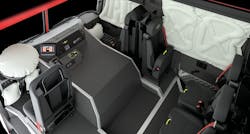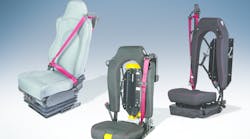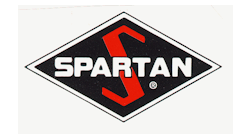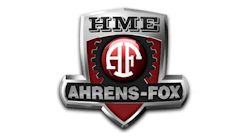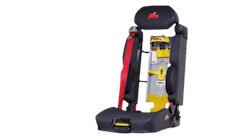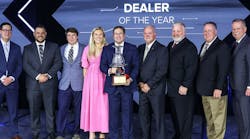Since manufacturers started putting roofs on emergency apparatus cabs, interiors have evolved with innovations and, in some cases, returned to the tried and true designs.
Customers are asking builders for clean and simple designs regarding interior surfaces, but are demanding the most sophisticated electronics and innovations usually left for high-end luxury vehicles.
While firefighters seem to be warming up to technology in their apparatus, the trend toward clean cabs—the concept of keeping carcinogens and biohazards out of the cabs—has been fully embraced and is a red-hot trend in the market today.
Firehouse recently talked to several apparatus builders that make their own cabs and chassis to learn the latest trends with cab interiors.
Technology
“I find firefighters today are more likely to embrace technology,” said Ken Lenz, vice president and director of engineering for HME/Ahrens-Fox, a truck and cab builder based in Wyoming, MI. “They grew up with it. They’re sort of digital kids, so they’re embracing it.”
Recently, HME/Ahrens-Fox has been introducing what Lenz calls “the glass cockpit,” a design that incorporates digital touch screens and displays to operate many of the functions of the apparatus.
“They’re not just screens,” Lenz said. “They are mini computers.” He described them as a type of artificial intelligence. “The machines are making the decisions,” he said, adding that the user or operator can override any of the functions as needed.
Spartan Motors also has touch screens available with full multiplexing, but a company spokesman said that kind of technology hasn’t really caught on in his opinion.
“Touch screens in cars have really caught on, but in the fire truck industry, it hasn’t caught on as quickly,” said Jeff Seal, the original equipment manufacturer (OEM) account manager for Spartan Motors, an apparatus and cab and chassis builder based in Charlotte, MI.
Seal said he believes touch screens are not as popular in the fire market because the driver has to search for controls as they drive at higher rates of speed.
“We’re finding the demand for touch screens is still rather slight,” Seal said.
Lenz and Seal agree, however, that customers are demanding more and more USB ports for mobile devices and cubbies for personal items than ever before.
“We’re sprinkling USB ports all over the place,” Lenz acknowledged. “That and cup holders and cubbies,” he added. “Everybody has a cell phone and they want the ability to plug them in.”
Seal agreed, noting that Spartan Motors has more than 150 options and configurations for cab-mounted USB ports.
He’s also seen a trend with cup holders.
“There was a time the old school chief’s didn’t want them,” Seal said. “Now, there’s one for the driver and the officer and the rear seats too.” He attributed that fad to the need and desire to keep hydrated.
E-ONE, an apparatus builder in Ocala, FL, that builds its own cabs and chassis, has also seen an increased demand for cup holders and personal storage places.
Joe Hedges, product manager for chassis and aerials for E-ONE, said customers are asking for more creature comforts, like cup holders and cubbies for personal belongings and E-ONE is installing them as customers request.
Hedges said E-ONE is also illuminating those cubbies and cup holders and other areas with soft lights, particularly over the dog house area where many items are often stored or mounted. He described the lighting as like those found in automobiles that wash over areas from above while the source is almost undetectable.
That soft light, red in color, is carried over the floor with a soft glow that brightens when doors are open, Hedges said.
“We’ve found that even the red lights can be overpowering,” Hedges said. “So we’ve placed lighting in targeted areas in the cab.” He further explained that the lights will dim when doors are closed.
And when it comes to storage, Hedges said there’s been a trend to have more EMS cabinets inside cabs.
“They’re now coming in all different sizes,” Hedges said. “They have interior and exterior cabinet doors. Sometimes both.”
As a custom builder, Hedges said E-ONE can create any variety of cabinets for cabs. He added that E-ONE recently had a customer that wanted a cabinet for every piece of equipment stored inside the cab.
“It looked a little out of place, but the chief said he wanted a place for everything and everything in its place,” Hodges said. “I have to commend him for that.”
Hedges said customers are also asking for cabinet space in the raised roof transition or Vista roof section of the cabs. He said many departments say they don’t need the windows in that area and would rather have the storage space over the rear-seating area.
Clean cabs
And, speaking of seating, Hedges said E-ONE offers all the seating selections—HO Bostrom, Valor and Seats Inc.—and increasingly, customers are asking for clean cab material, like vinyl, on the seats.
“With vinyl seats, they can give them a thorough scrubbing and biohazards and carcinogens are not as much of a problem,” Hedges said.
Vinyl seats are components of what many in the industry are calling “clean cabs.” A clean cab is one that makes it easier to clean carcinogens and biohazards from the cab interior surfaces.
“In the industry, ‘clean cab,’ in reality, means different things to different customers,” Hedges said. They each have a reason for requesting them and they each have a definition of what it means.”
For some, it means severe duty interiors with metal not just on the door panels, but overhead on the ceiling, on AC covers and other places where firefighters could bang into them with gear and tools. Painted and metal surfaces that have no texture are easier to clean and decontaminate too, Hedges added.
For other customers, like firefighters in the Miami-Dade, FL, Fire Department, it means having cabinets outside of the cabs for bunker gear and SCBAs so the primary sources of contaminants never get inside of the cabs, Hedges said.
That concept might work for some departments, but Hedges points out that some departments work in climates where temperatures can go to 10 below zero. In those cases, Hedges said E-ONE has a temperature controlled, garden hose system used for gross decontamination at the scene and those departments thoroughly clean their cabs when they return to the station and are back in service.
E-ONE has also been working on a high-power, high-quality HEPA filtration system for the cab interiors. Hedges said it’s important to have one designed properly for the apparatus because improperly or poorly designed systems can hamper the apparatus heating, air conditioning and ventilation system. Hedges said E-ONE is in the prototype process of HEPA filtration and the design is promising.
Both Lenz, at HME/Ahrens-Fox and Seal at Spartan have seen spikes in clean cab requests recently and each company has responded to customer requests.
“Clean cabs are all the rage right now,” Lenz said. “So, we are offering the cab interiors and components that are easier to clean and seats with no threads.”
Lenz said he understands the need to keep things clean, but doesn’t quite understand why departments need that design if the dirty gear isn’t supposed to be in the cab in the first place.
“If we’re providing a place for them to put their dirty gear, why do they need to have clean cab interiors,” Lenz asked.
Nevertheless, Lenz said his company is offering metal interior surfaces and coatings that are easy to clean. He added that cab interiors seem like they have gone full circle. When Lenz entered the fire service industry 41 years ago, he said the interiors of all the apparatus were painted metal. They evolved into padding and the plastic ABS molded trim work that was more automotive in styling, he said. Now, they’ve headed back to metal and paint.
“It’s like the retro Mustang, we had that before,” Lenz said. “And the retro Challenger, we had that too. …It’s like everything goes in circles.”
Seal, too, has noticed the trend for extreme-duty interiors which he said is an option that falls into the clean cab trend. He said ABS molded plastic looks nice and sleek at first, but they don’t hold up as well over the life of the apparatus.
“We’ve seen [pickup] bed liner coatings become very popular in the cabs,” Seal said.
Seal said Spartan Motors allows the customers to pick and choose any combination of the 23,000 options the company has for cab interiors. In other words, if a customer wants a Line-X bed coating interior, they don’t have to purchase another set of options or step up to another, more expensive model, like some automotive buyers might.
He said Spartan will also allow the customer to pick and choose where the liner material is applied rather than to go to the expense of having the entire cab coated when it might not be necessary.
Like Lenz, Seal said Spartan will create cabinets for gear and SCBAs accessible from the outside, creating an isolation point that won’t allow the carcinogens and biohazards into the cab.
“It looks like the fire service is going in the direction of clean cabs,” Seal said, adding that firefighters want removable materials for their seats and stainless steel and aluminum for other surfaces that can be easily wiped down. “We have several different options and different ways to address the issue,” he said.
Electronics
Another area that Seal said Spartan is trying to address regarding cab interiors is to make it easier to install components, especially third-party components. He said many fire departments have their radios and communication equipment installed after delivery. To make for a cleaner installation, Spartan has been focusing on pre-wiring for anticipated equipment and providing “clean power” outlets or lugs at strategic places in the cabs. Seal said if the wrong power line is cut or spliced into, with today’s modern wiring, the apparatus engine, or transmission performance might be affected. Even pump performance can be affected, he said.
“We have more than 1,000 different configurations for electrical supply,” Seal added.
E-ONE has also been doing some work with power supplies, but with slightly different requirements.
Hedges said E-ONE has been focusing on a battery-powered Auxiliary Power Unit (APU) designed to shut down apparatus when at idle to reduce emissions and conserve fuel. They are custom tailoring units for use in fire apparatus, Hedges said, noting the system is based on a lithium battery pack.
“It’s completely silent,” Hedges said. “There’s no fumes. There’s no auxiliary diesel engine. There’s no maintenance.”
Hedges said the system knows when the engine is at idle and there’s no pump engaged, or aerial deployed or any mission critical devices are in use. It will shut down the apparatus engine and keep all the accessories, including heating and air conditioning, up and running. The lead-acid batteries used to start the truck are completely separated and cannot be discharged by the components being used, which means the apparatus will always start back up, Hedges said.
“We’re excited to bring that to market,” he said. “We have a lot of neat stuff cooking.”
Lenz said HME/Ahrens-Fox has a few things cooking too. The glass panel controls can be located just about anywhere and can control just about anything, including pump operations, Lenz said. He added that wherever a customer wants a pump panel, including all four corners of an apparatus and potentially in the cab, the company can do it.
The glass panel technology is also available in a new wildland fire apparatus based on a custom-style cab and chassis called the AF-WUI, Lenz said, noting the new design takes the “needs and greeds” of what wildland firefighters want in a cab and eliminates the things they don't like. It was a concept introduced a few years ago and has been catching on.
Seal said Spartan is also excited to be working on designs that offer firefighters more room in the cabs. As emission requirements require more space for engine components and cooling systems, the engine covers, or dog houses, have gotten bigger, reducing interior cab space.
“We’re seeing a greater demand, and a greater request for more room,” Seal said. “With larger engines and larger cooling systems and the engine tunnel growing, we’ve focused on how we can make our cabs roomier, not only for comfort, but for ease of egress with gear.”
Spartan has shrunk its engine tunnels, and provided more hip room and more space in the rear of cab too, Seal said, noting that more room is needed for seatbelt use and getting in and out of the apparatus.
Another area Spartan has focused on is internet connectivity, Seal said.
“It’s like Wi-Fi on steroids,” Seal said of the system used by Spartan, which can handle up to 10 users streaming videos.
And when there’s no Wi-Fi available, Seal said Spartan can offer satellite radio internet systems.
“That’s good for areas where there are no towers, or when a storm, like Superstorm Sandy, has knocked out the infrastructure and the systems are down.”
Seal said the best thing for firefighters to do when looking at cab features and interior specifications is to look for those with the most options to fit the customers’ needs.
“Because what might be important to people on the East Coast might not be beneficial to those on the West Coast,” Seal said.
